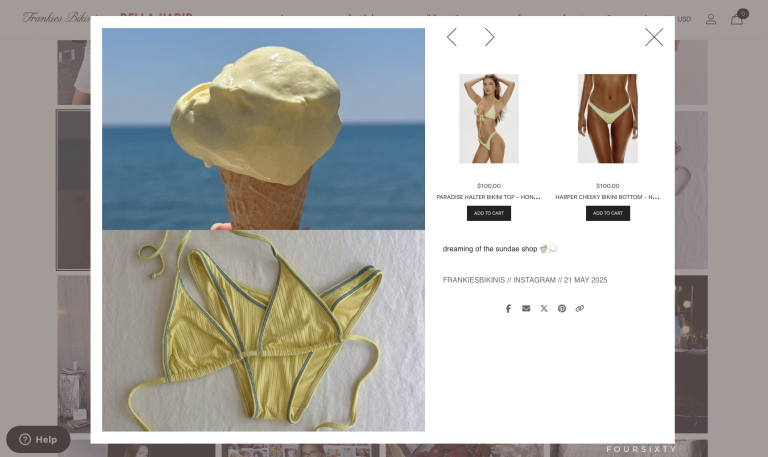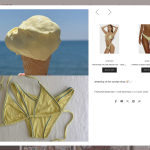Disclaimer: Since our product at Foursixty fits right into this topic, we’ve mentioned our services a few times in the piece below.
Shoppable content is any type of content—like a photo, video, or blog post—that lets people buy products directly from it.
Picture this: you’re a fashion brand, and someone in your target audience sees one of your posts on their Instagram feed. They instantly fall in love with the outfit featured in the post and want to buy it.
With shoppable content, they don’t have to search your website, scroll through endless product pages, or DM you to ask, “Where’s this [insert epic outfit here] from?”
They just tap the photo, see the product details, and check out from within the app—or an integrated point-of-sale page.
That’s the power of shoppable content.
Why Shoppable Content Matters in 2025
In 2025, shoppable content isn’t just nice to have. Users are starting to expect shoppable posts. This is particularly true for younger audiences who have grown up with social media platforms.
Facebook and Instagram were born when Millennials were teenagers and young adults. Gen Z is the first digitally native generation. They’ve never known a world without the internet and social media.
Even the older generations spend tons of time on social platforms.
Data pulled from a 2024 Pew Research Center survey shows that of people aged 50-64—a mix of Gen X and Baby Boomers—70% use Facebook, 36% are on Instagram, and 86% visit YouTube regularly.
The numbers are even higher for younger generations.
And these shoppers want seamless shopping experiences. They don’t want to jump between apps, search for product names, or navigate ecommerce websites until they find that cool tank top they saw on TikTok.
They want to see something they love while browsing social media and be able to buy it instantly.
This nonlinear funnel is worlds away from the predictable customer journey of the past.
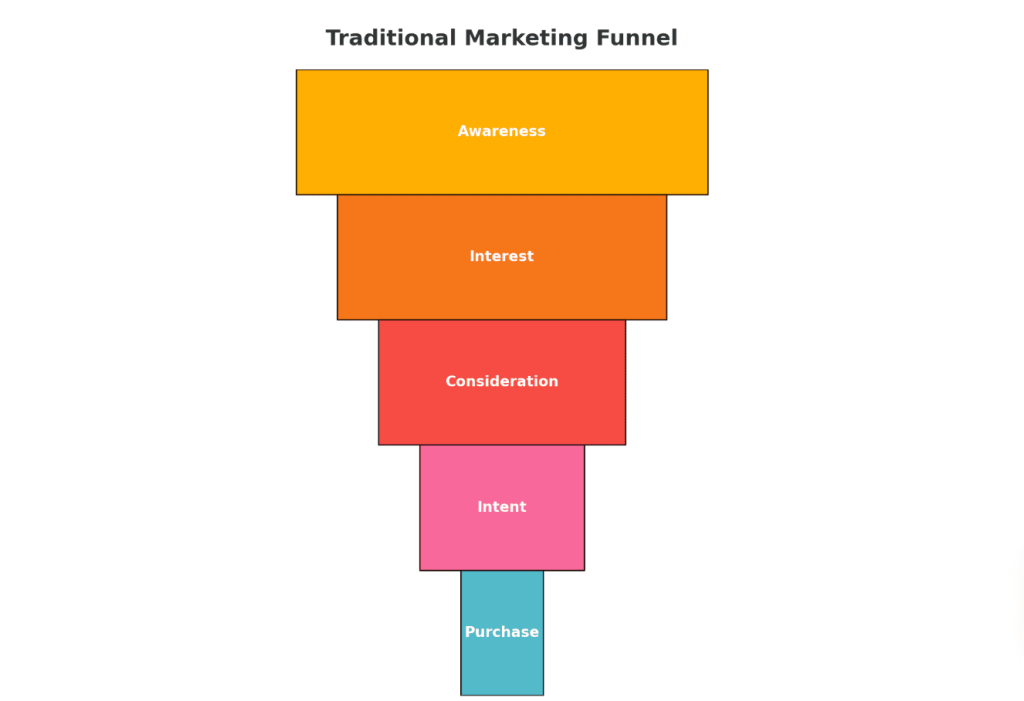
Recent Boston Consulting Group (BCG) analysis shows that there’s really nothing linear about how people shop in 2025.
Instead, BCG argues that business owners should map their customer journeys around new behaviors—what they call the 4S behaviors:
- Streaming
- Scrolling
- Searching
- Shopping
Consumers don’t follow a straight line through these behaviors. They jump between social feeds, video streams, search engines, and online stores in seconds.
That’s exactly where shoppable content comes in.
When you embed shopping opportunities directly into social posts, videos, blogs, and livestreams, you meet customers in the ripe, juicy moment across multiple touchpoints.
You remove extra steps they’d take in a traditional funnel and make buying easier than ever before.
Before we get to the meat of this guide, let’s explore the different types of shoppable content.
The 6 Main Types of Shoppable Content
You can turn all sorts of things into shoppable posts, but we’ll focus on the six main types of shoppable content:
- Social media: Platforms like Instagram, TikTok, Facebook, and Pinterest now offer in-app shopping tools. These shoppable posts, stories, reels, and pins let users buy products straight from their feeds.
- Video and livestream shopping: Short-form videos, YouTube clips, and live-streams on platforms like TikTok Live, Amazon Live, and Instagram Live let viewers shop products in real time or straight from video overlays.
- Blog and editorial content: Brands create blog posts, articles, gift guides, and lookbooks embedded with direct product links. This makes it easy for readers to shop the items mentioned in the content, all without leaving the page.
- User-generated content (UGC): Real customers post photos, video content, and reels featuring your products. You then repost this user-generated content with direct shopping links to drive conversions. (Note: this involves a solid UGC strategy for sourcing high-quality customer content, getting permission to repost, and tagging products.)
- Shoppable ads: Interactive ads on sites like Instagram, TikTok, Google, and YouTube let users click directly on a product from inside the ad.
- Influencer integrations: Creators feature products in their content—like a “get ready with me” video or product haul—and integrate direct shopping links or in-app checkout options.
Now for the fun part: real examples of shoppable content in action!
Examples of Effective Shoppable Content
We’ve rounded up three shoppable content examples to help show you how it works.
1. Frankies Bikinis + Instagram
For our first example, we’ll put a spotlight on Instagram shopping through beautiful product photography. Brands that use Shopify as their ecommerce platform can connect Shopify to Instagram to create shoppable images and posts.
That’s what Frankies Bikinis does with its popular bikinis. (PS: Frankies Bikinis just so happens to be one of our customers here at Foursixty. You can visit our homepage to learn more about what we do.)
Take this Instagram image of a model wearing a Frankies Bikinis swimsuit. Customers can click on the swimsuit bottoms and top to see a product tag with a short description and link.
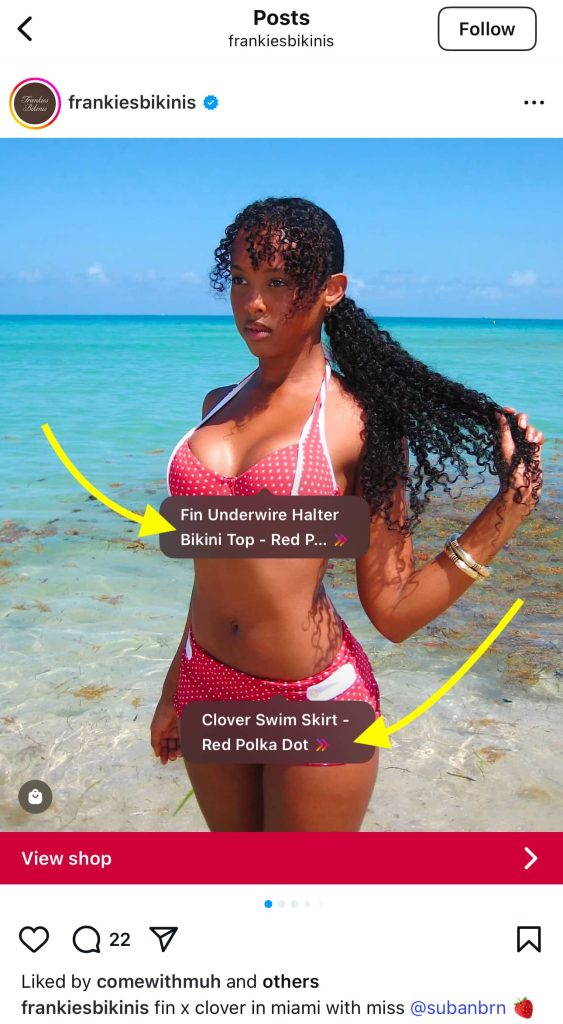
If shoppers want to buy these items, all they have to do is click. They’ll go straight to the Frankies Bikinis pricing and product page, where they can choose a size and add the item to their cart.
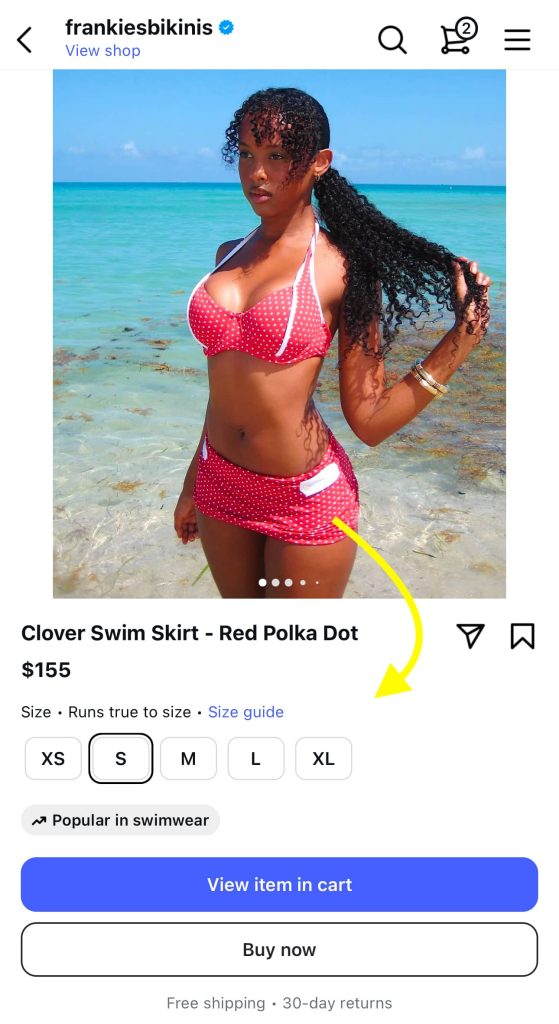
From there, they can shop around for other Frankies apparel in the product catalog or check out—all without leaving the Instagram app.
This is the literal definition of a shoppable social media post.
Pretty neat, right?
2. My Little Daisy Co + TikTok
TikTok is one of the most popular apps for Millennials and Gen Zers.
This makes it an excellent place to sell products. Brands can upload videos and add a prominent link to the products shown in the video, like TikTok seller My Little Daisy Co does in the screenshot below.
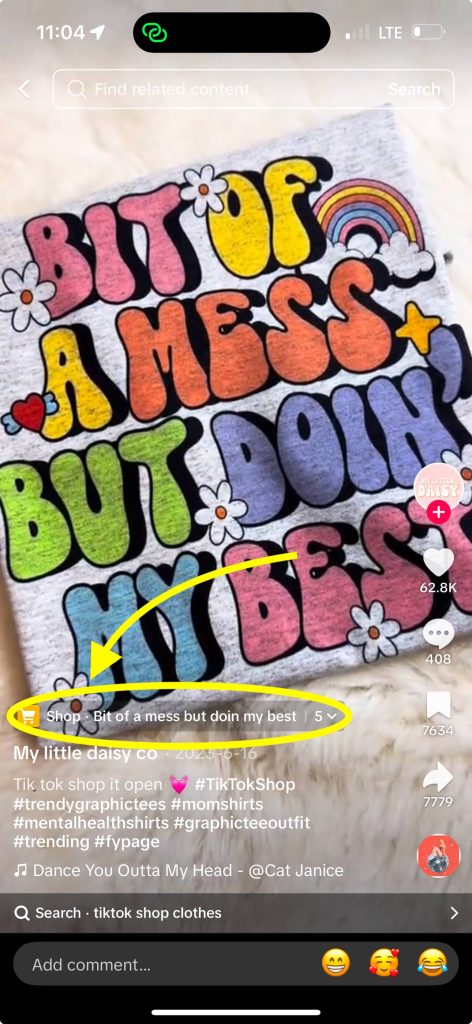
Click the featured link and a page with links to every product featured in the shoppable video pops up. You can pick a product (or several), select the size(s) you want, add it to your cart, and check out.
All without leaving TikTok.
3. Pura Vida Bracelets + Website
Pura Vida Bracelets is another client of ours, and they’ve got shoppable content right there on their website.
The shoppable content here is in the form of a shoppable Instagram gallery that appears on the homepage of the Pura Vida website.
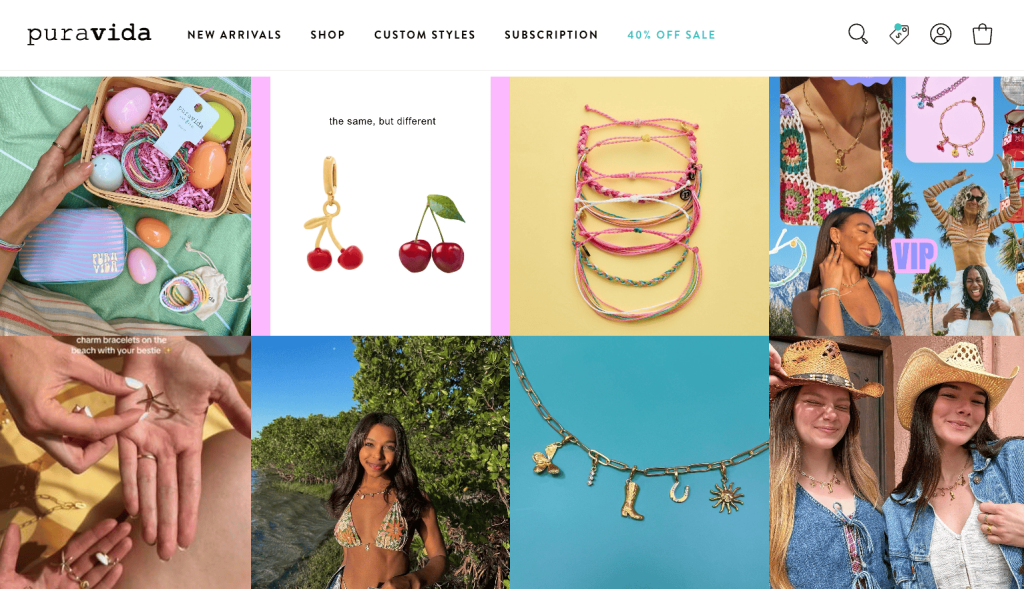
When you hover over any of these images, you see a button that says, “Shop the Look.” Click on that and you’ll see an overlay with links to each featured product.
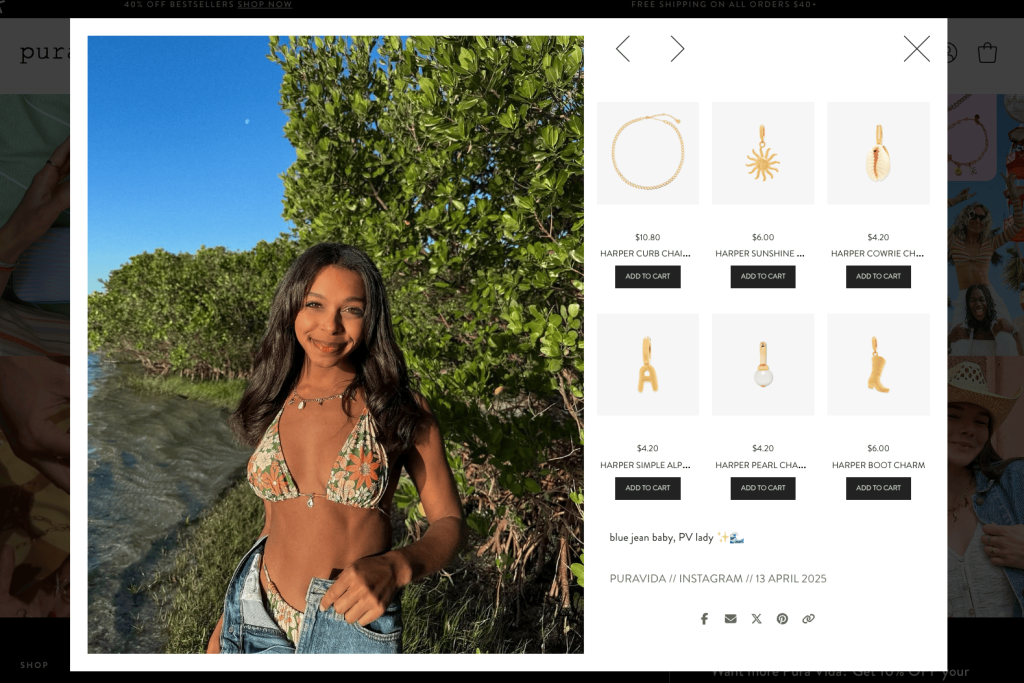
From here, users can add items to their cart, explore other products, and check out.
How to Create Shoppable Content
If you’re ready to turn your content into a sales machine, the good news is this: it’s easier than ever.
Here’s how to get started.
Tools and Platforms You’ll Need
First, you need the right platforms to support shoppable experiences. Here are a few of the most popular:
- Shopify: This powerful ecommerce platform easily integrates with social media platforms to create shoppable social posts, blogs, and ads. It’s also the most popular ecommerce website builder around.
- TikTok: If you’re already on TikTok, it’s a no-brainer to set up a TikTok Shop for your store. TikTok’s built-in shopping feature that lets you add product links to videos, live-streams, and your profile.
- Instagram: Love posting brand content on Instagram? With Instagram’s shopping features, tag products in posts, Reels, and Stories—and set up a full Instagram shop.
- Pinterest: Pinterest may not be as popular as some of the other social media platforms on this list, but it still packs a punch. You can turn Pins into Product Pins so users can browse and buy right from the app.
- YouTube: Tons of people watch YouTube every day. If you’re on the platform, you can link products directly under your YouTube videos with integrated shopping tools.
Here’s a quick tip: don’t try to put your content on all of these shoppable content platforms. Unless you have a whole team to manage shoppable content on each platform, you’ll get overwhelmed quickly. Instead, choose the platforms you enjoy the most and invest your time and effort there.
Take TikTok and Instagram, for example. Monetization on TikTok leans heavily on viral short-form videos and trending hashtags.
Instagram monetization focuses more on shopping straight from images, Reels, and curated Shops. Both platforms are powerful. The best choice depends on your brand’s style and audience.
If you’d rather take pictures and create beautiful reels than make off-the-cuff videos or chase trends, Instagram is probably a better choice. If the opposite is true, TikTok is your winner.
Regardless of the platform you choose, it probably has a pretty straightforward onboarding flow.
Generally, you connect your product catalog to the platform, tag items, and start creating shoppable content that drives sales.
Let’s take a closer look.
Technical Implementation
Setting up shoppable content usually follows these basic steps:
- Connect your product catalog: You’ll need to sync your inventory with the platform you’re selling on (like TikTok Shop, Facebook Commerce Manager, and Pinterest). You don’t have to do it manually, though. There are built-in integrations and apps that automate this process.
- Enable shopping features: Most platforms will guide you through setting up a shop section or activating product tagging.
- Tag products: Once you post a photo, video, or article, use built-in tools to tag specific products from your catalog.
- Test the experience: Before you go live, do a test run. Make sure product links work, the checkout processes are smooth, and the customer journey feels effortless.
- Track performance: Use the platform’s analytics tools to monitor clicks, sales, and overall conversion rates. Regularly measuring the ROI of shoppable content helps keep you learning and improving.
For a deeper dive into what the implementation process looks like, check out our guide to connecting Instagram and Shopify.
Shoppable Content Tips
Creating shoppable content isn’t just about adding links to cool pictures and videos. There’s got to be a beating heart at the center of each piece of content you put out there.
Instead of focusing on selling products, use the content to show how your product solves a problem or fits into a lifestyle. Focus on creating conversion-oriented content. This is content that’s not just pretty, but moves your audience from browsing to buying.
Next, make sure everything looks fabulous on mobile platforms. Most shoppable content experiences happen on phones, not desktops, so mobile functionality is a priority here.
Add shoppable content to your website, but always with a careful eye toward mobile optimization.
And finally, carefully read the platform policies for every tool you use. Each social media platform has strict rules around what you can sell and how you present it.
Always double-check that your products meet content guidelines. This is especially relevant for industries like beauty, health, and supplements.
The more closely you follow every rule and guideline, the better.
Want to Turn Your UGC or Social Posts into a Revenue Stream?
If you’re posting UGC, videos, or editorial content without making it shoppable, you’re leaving money on the table.
Here at Foursixty, we help brands monetize content across Instagram, TikTok, email, and their own websites.
How? By turning customer photos and social posts into clickable galleries, product-tagged visuals, and embeddable shopping experiences.
Whether you’re working with influencers, running campaigns on TikTok Shop, or curating a lookbook for your blog, Foursixty gives you the tools to embed shoppable content anywhere your customers are browsing.
Ready to turn your content into conversions with powerful social proof? Let’s make your shoppable UGC happen. Start your 14-day free trial today to begin making money with UGC and social commerce.
FAQs
How do shoppable videos and LIVE Shopping enhance user interaction and purchasing on TikTok Shop?
Shoppable videos and live shopping create a dynamic, real-time experience for shoppers. Instead of passively watching content, viewers can click through directly from videos or live streams to purchase products, all without leaving TikTok.
This smooth customer experience taps into the power of social shopping. This is where seeing a product in action, modeled by a real person in a real-life setting, builds instant trust and excitement.
In short, shoppable videos and live shopping reduce friction, shorten the path to purchase, and capture the attention of potential customers who are already primed to shop while they scroll.
What does shoppable content mean?
Shoppable content means digital content—like videos, blog posts, or social media posts—that allows users to purchase products directly from the content itself. It’s a form of content marketing that’s expected to get more and more popular every year.
Ecommerce brands can use shoppable content to drive customer engagement, showcase new products, and increase conversions.
How can I create effective shoppable content for my brand?
Start by defining a clear marketing strategy that aligns with your brand’s goals.
Then:
Build partnerships with influencers or loyal customers to gather authentic customer reviews and curate real-world usage of your products.
Choose the right format for your audience—social media posts, blog articles, short videos, or live shopping sessions. Do you want to monetize TikTok or Instagram? Pinterest or YouTube?
Whichever platform you choose, focus on creating a smooth customer experience by tagging products clearly and fast, mobile-friendly checkout options.
Use a reliable content platform to manage and distribute your shoppable content across channels.
Above all, remember that successful shoppable content feels organic, engaging, and part of the natural social shopping journey—not like an obvious hard sell.



